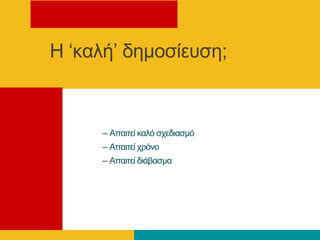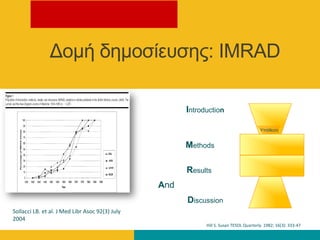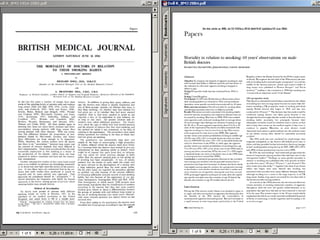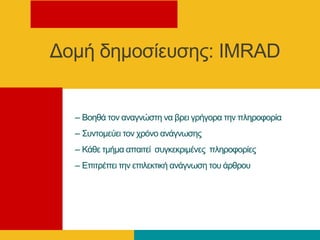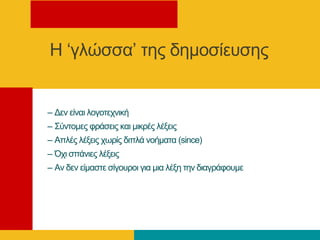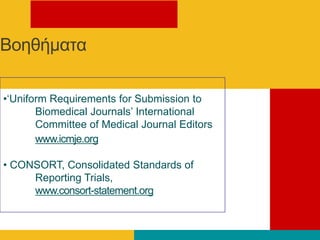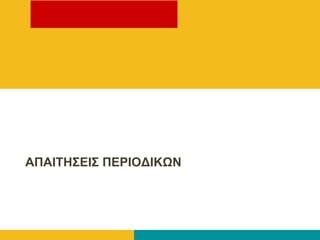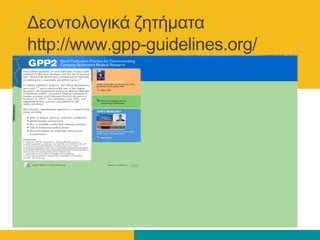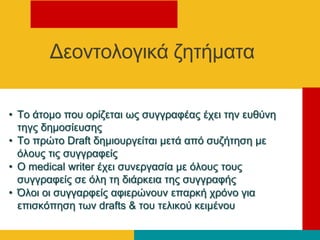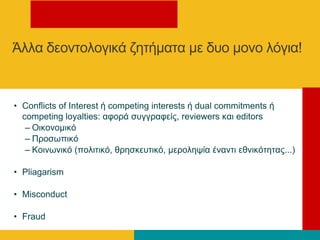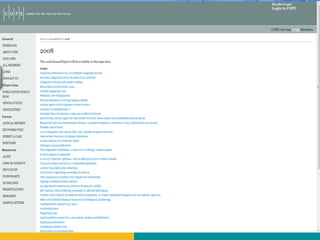Reflections on publications
- 1. ╬Ģ╬Ö╬Ż╬æ╬ō╬®╬ō╬Ś ╬Ż╬ż╬Ś ╬ö╬Ś╬£╬¤╬Ż╬Ö╬Ģ╬ź╬Ż╬Ś ╬æ╬Č╬▒╬╗╬▒╬Č╬»╬▒ ╬£ŽĆ╬Ą╬╗╬Ł╬Ė╬ĮŽĆ Medical Writer medical.papers@abenekou.net
- 2. ╬ż╬» ╬Ą╬»╬╗╬▒╬Ę ╬Ą ╬┤╬Ą╬║╬Į╬Č╬»╬ĄŽĆ╬Č╬Ą; ŌĆó ╬öŽĆ╬Ę╬Ė╬Į╬Ę╬╗Žā╬╗╬»╬▒ ŌĆó ╬ö╬╗╬Ą╬║╬Ł╬ŠŽā╬Č╬Ą ŌĆó ╬ö╬ĖŽĆ╬▒╬»╬┤╬ĄŽĆ╬Č╬Ą
- 3. ╬ż╬» ╬ČŽĆ╬╗╬ŁŽĆ╬Ą╬Ę╬Ą╬┐ ╬ŁŽü╬Ą╬Ę; ŌĆó ╬Ā╬Į╬╣╬╣╬Ł╬┐ ╬Č╬Ę╬Ą ╬┤╬Ą╬║Žī╬Č╬Ę╬▒ ŽĆ╬│╬Ą╬»╬▒ ŌĆō╬Ė╬▒╬Ę╬ĄŽĆ╬ČŽĆ╬╗╬Ę╬«╬Š╬Ę╬Ą╬┐ ╬Į╬┤╬Ą╬│╬»╬Ą╬┐ ŌĆō╬Ė╬▒╬Č╬Ą╬║╬Ą╬Š╬Ę╬╗╬« ╬▒╬╗╬Ę╬Ę╬║╬Ą╬ĘŽÄŽĆ╬Ę╬Č╬Ą ╬▒╬Č╬Č╬Ą╬╗ŽÄ╬╗ ŌĆōevidence-based medicine
- 4. ╬Ś ŌĆś╬Ė╬▒╬╣╬«ŌĆÖ ╬┤╬Ą╬║╬Į╬Č╬»╬ĄŽĆ╬Č╬Ą; ŌĆō ╬Ā╬Š╬ĮŽĆŽĆ╬Į╬Č╬Ł╬Ę╬Ą╬Ę ╬Ė╬▒╬╣╬« ╬Ł╬Š╬ĄŽĆ╬╗╬▒ ŌĆō ╬Ā╬Š╬Į╬Č╬Č╬Ł╬Ę╬Ą╬Ę ╬Č╬Ę╬Ą╬╗ ŽĆŽĆ╬¼╬ŠŽü╬ĮŽĆ╬Č╬▒ ╬│╬╗ŽÄ╬Č╬Ą ŌĆō ╬ö╬»╬╗╬▒╬Ę ŌĆś╬Ł╬╗╬Ę╬Ę╬║╬ĄŌĆÖ ŌĆō ╬Ż╬Ł╬▓╬Ą╬Ę╬▒╬Ę ╬Ę╬ĮŽĆ╬┐ ╬ČŽĆ╬║╬║╬Ą╬Ę╬ŁŽü╬Į╬╗╬Ę╬Ą╬┐ ╬Č╬Ę╬Ą ╬║╬Ą╬╣╬Ł╬Ę╬Ą ŌĆō ╬Ż╬Ł╬▓╬Ą╬Ę╬▒╬Ę ╬Ę╬ĮŽĆ╬┐ ╬▒╬╗╬▒╬│╬╗ŽÄ╬Č╬Ę╬Ą╬┐
- 5. ╬Ś ŌĆś╬Ė╬▒╬╣╬«ŌĆÖ ╬┤╬Ą╬║╬Į╬Č╬»╬ĄŽĆ╬Č╬Ą; ŌĆō ╬æŽĆ╬▒╬Ę╬Ę╬Ą╬» ╬Ė╬▒╬╣Žī ╬ČŽü╬Ą╬┤╬Ę╬▒╬Č╬║Žī ŌĆō ╬æŽĆ╬▒╬Ę╬Ę╬Ą╬» Žü╬ŠŽī╬╗╬Į ŌĆō ╬æŽĆ╬▒╬Ę╬Ę╬Ą╬» ╬┤╬Ę╬¼╬▓╬▒╬Č╬║╬▒
- 6. ╬ō╬Į╬║╬« ╬┤╬Ą╬║╬Į╬Č╬»╬ĄŽĆ╬Č╬Ą╬┐: IMRAD Hill S. Susan TESOL Quarterly. 1982; 16(3): 333-47 Introduction Methods Results Discussion ╬źŽĆŽī╬Č╬Ą╬Č╬Ą Sollacci LB. et al. J Med Libr Asoc 92(3) July 2004 And
- 8. ╬ō╬Į╬║╬« ╬┤╬Ą╬║╬Į╬Č╬»╬ĄŽĆ╬Č╬Ą╬┐: IMRAD ŌĆō ╬Æ╬Į╬Ą╬Č╬¼ ╬Ę╬Į╬╗ ╬▒╬╗╬▒╬│╬╗ŽÄ╬Č╬Ę╬Ą ╬╗╬▒ ╬▓╬Š╬Ą╬Ę ╬│╬Š╬«╬│╬Į╬Š╬▒ ╬Ę╬Ą╬╗ ŽĆ╬╣╬Ą╬Š╬Į╬Ė╬Į╬Š╬»╬▒ ŌĆō ╬ŻŽĆ╬╗╬Ę╬Į╬║╬ĄŽŹ╬Ą╬Ę ╬Ę╬Į╬╗ Žü╬ŠŽī╬╗╬Į ╬▒╬╗╬¼╬│╬╗Žā╬Č╬Ą╬┐ ŌĆō ╬Ü╬¼╬Č╬Ą ╬Ę╬║╬«╬║╬▒ ╬▒ŽĆ╬▒╬Ę╬Ę╬Ą╬» ╬ČŽĆ╬│╬Ė╬Ą╬Ė╬Š╬Ę╬║╬Ł╬╗╬Ą╬┐ ŽĆ╬╣╬Ą╬Š╬Į╬Ė╬Į╬Š╬»╬Ą╬┐ ŌĆō ╬öŽĆ╬Ę╬Ę╬Š╬ŁŽĆ╬Ą╬Ę ╬Ę╬Ą╬╗ ╬ĄŽĆ╬Ę╬╣╬Ą╬Ė╬Ę╬Ę╬Ė╬« ╬▒╬╗╬¼╬│╬╗Žā╬Č╬Ą ╬Ę╬ĮŽĆ ╬¼╬Š╬Č╬Š╬ĮŽĆ
- 9. IMRAD:╬Ą╬ŠŽā╬Ę╬«╬Č╬Ą╬Ę╬┐ ╬┤╬Ą╬Ę╬ĮŽŹ╬╗ ╬▒ŽĆ╬¼╬╗╬Ę╬Ą╬Č╬Ą ŌĆō Title & abstract: ╬╗╬▒ ╬Ę╬Ą ╬┤╬Ę╬▒╬▓╬¼╬ČŽā; ŌĆō Introduction: ╬│╬Ę╬▒╬Ę╬» ╬Ł╬Ė╬▒╬╗╬▒╬╗ ╬Ę╬Ą╬╗ ╬Ł╬Š╬ĄŽĆ╬╗╬▒; ŌĆō Methods: ŽĆŽā╬┐ ╬Ę╬Ą╬╗ ╬Ł╬Ė╬▒╬╗╬▒╬╗; ŌĆō Results: ╬Ę╬Ę ╬▓╬Š╬«╬Ė╬▒╬╗; ŌĆō Discussion: ╬Ę╬Ę ╬Č╬Ą╬║╬▒╬»╬╗╬Ą╬Ę;
- 10. ╬Ż╬Ę╬Ę╬│╬║╬Ł╬┐ ŽĆ╬Ą╬Š╬Ę╬ČŽĆ╬╣╬╣╬Į╬│╬«╬┐ ŌĆō ╬ż╬Ę ╬ŁŽüŽā ╬╗╬▒ ŽĆŽā; ŌĆō ╬ō╬Ę╬▒╬Ę╬» ╬▒╬╝╬»╬┤╬Ą╬Ę ╬╗╬▒ ╬Ę╬Į ŽĆŽā; ŌĆō ╬ĀŽā╬┐ ╬Ą╬Ę╬╗╬▒╬Ę ╬Ė╬▒╬╣ŽŹ╬Ę╬Ą╬Š╬▒ ╬╗╬▒ ╬Ę╬Į ŽĆŽā; ŌĆō ╬Ā╬Į╬ĘŽī╬╗ ╬Ą╬╗╬┤╬Ę╬▒╬Ė╬Ł╬Š╬Ą╬Ę; (ŽĆ╬Į╬ĘŽī ╬Ą╬»╬╗╬▒╬Ę ╬Ę╬Į ╬Ė╬Į╬Ę╬╗Žī) ŌĆō ╬Ā╬Į╬ĘŽī ╬Ą╬»╬╗╬▒╬Ę ╬Ę╬Į ╬Ė╬▒╬Ę╬¼╬╣╬╣╬Ą╬╣╬Į ŽĆ╬Ą╬Š╬Ę╬Į╬┤╬Ę╬ĖŽī; ŌĆō ╬Ā╬Į╬Ę╬Ł╬┐ ╬Ą╬»╬╗╬▒╬Ę ╬Į╬Ę ╬▒ŽĆ╬▒╬Ę╬Ę╬«╬Č╬Ą╬Ę╬┐ ╬ĘŽā╬╗ ŽĆ╬Ą╬Š╬Ę╬Į╬┤╬Ę╬ĖŽÄ╬╗; ŌĆō ╬ś╬▒ ╬▒╬Ė╬Ę╬Ą╬ŠŽÄ╬ČŽā Žü╬ŠŽī╬╗╬Į; ŌĆō ╬ö╬»╬║╬▒╬Ę ╬Ł╬Ę╬Į╬Ę╬║╬Į╬┐(╬Ą) ╬╗╬▒ ŽĆ╬¼╬ŠŽā ╬Ę╬Ą╬╗ ╬┤╬Ą╬║Žī╬Č╬Ę╬▒ ╬ĄŽĆ╬ČŽŹ╬╗╬Ą;
- 11. ŌĆó ╬Ā╬Į╬ĘŽī ╬Ę╬║╬«╬║╬▒ ╬│╬Š╬¼╬ĖŽā ŽĆ╬ŠŽÄ╬Ę╬Į;; ŌĆó ╬Ā╬ŠŽī╬Ę╬▒╬Č╬Ą: ŌĆó Methods ŌĆó Results ŌĆó Introduction ŌĆó Discussion ŌĆó Abstract ╬ō╬Ą╬╗╬Ę╬Ė╬¼ ╬│╬Ę╬▒ ╬Ę╬Ą ╬ČŽĆ╬│╬│╬Š╬▒╬Ė╬«
- 12. ╬Ś ŌĆś╬│╬╣ŽÄ╬Č╬Č╬▒ŌĆÖ ╬Ę╬Ą╬┐ ╬┤╬Ą╬║╬Į╬Č╬»╬ĄŽĆ╬Č╬Ą╬┐ ŌĆō ╬ō╬Ą╬╗ ╬Ą╬»╬╗╬▒╬Ę ╬╣╬Į╬│╬Į╬Ę╬ĄŽü╬╗╬Ę╬Ė╬« ŌĆō ╬ŻŽŹ╬╗╬Ę╬Į╬║╬Ą╬┐ ╬Ė╬Š╬¼╬Č╬Ą╬Ę╬┐ ╬Ė╬▒╬Ę ╬║╬Ę╬Ė╬Š╬Ł╬┐ ╬╣╬Ł╬╝╬Ą╬Ę╬┐ ŌĆō ╬æŽĆ╬╣╬Ł╬┐ ╬╣╬Ł╬╝╬Ą╬Ę╬┐ ŽüŽā╬Š╬»╬┐ ╬┤╬ĘŽĆ╬╣╬¼ ╬╗╬Į╬«╬║╬▒╬Ę╬▒ (since) ŌĆō ╬īŽü╬Ę ╬ČŽĆ╬¼╬╗╬Ę╬Ą╬┐ ╬╣╬Ł╬╝╬Ą╬Ę╬┐ ŌĆō ╬æ╬╗ ╬┤╬Ą╬╗ ╬Ą╬»╬║╬▒╬Č╬Ę╬Ą ╬Č╬»╬│╬ĮŽĆ╬Š╬Į╬Ę ╬│╬Ę╬▒ ╬║╬Ę╬▒ ╬╣╬Ł╬╝╬Ą ╬Ę╬Ą╬╗ ╬┤╬Ę╬▒╬│╬Š╬¼╬Ė╬ĮŽĆ╬║╬Ą
- 13. ╬Æ╬Į╬Ą╬Č╬«╬║╬▒╬Ę╬▒ ŌĆóŌĆśUniform Requirements for Submission to Biomedical JournalsŌĆÖ International Committee of Medical Journal Editors www.icmje.org ŌĆó CONSORT, Consolidated Standards of Reporting Trials, www.consort-statement.org
- 14. ╬å╬╣╬╣╬▒ Checklists Checklist ╬Ģ╬»╬┤╬┐Žé ╬ĄŽü╬│╬▒╬Č╬»╬▒Žé URL CONSORT Randomized controlled trials http://www.consort-statement.org STARD Studies of diagnostic accuracy www.stard-statement.org PRISMA (ŽĆ╬▒╬╗╬╣╬¼ QUOROM) Systematic reviews and meta- analyses http://www.consort- statement.org/resources/related- guidelines-and-initiatives/ STROBE Observational studies in epidemiology (cohort, case- control, cross-sectional) http://www.strobe-statement.org MOOSE systematic reviews of observational studies http://www.consort- statement.org/about- consort/impact-of- consort/influence-on-related- reporting-guidelines/ REMARK Tumor marker prognostic studies TREND Non-randomized evaluations of behavioural and public health interventions
- 15. ╬¤ ╬╗Žī╬│╬┐Žé ╬│╬╣╬▒ ╬Ę╬┐╬Į ╬┐ŽĆ╬┐╬»╬┐ ╬Č╬║╬Ą╬Ė╬ĘŽī╬╝╬▒╬Č╬Ę╬Ą ╬Į╬▒ ╬┤╬╣╬▒╬▓╬¼╬Č╬┐Žā╬╝╬Ą ╬Ł╬Į╬▒ ╬¼Žü╬ĖŽü╬┐ ╬ĢŽĆ╬╣╬╗╬┐╬│╬« ŽĆ╬ĄŽü╬╣╬┐╬┤╬╣╬║╬┐ŽŹ
- 19. Authorship credit should be based on 1) substantial contributions to conception and design, acquisition of data, or analysis and interpretation of data; 2) drafting the article or revising it critically for important intellectual content; and 3) final approval of the version to be published. Authors should meet conditions 1, 2, and 3. http://www.icmje.org/ethical_1author.html Authorship: ICMJE criteria
- 20. Contributors
- 21. ŌĆó Ghost authorship ŌĆó Guest authorship ╬ō╬Ą╬Į╬╗╬Ę╬Į╬╣╬Į╬│╬Ę╬Ė╬¼ ╬┤╬Ą╬Ę╬«╬║╬▒╬Ę╬▒
- 23. ŌĆó ╬ż╬Į ╬¼╬Ę╬Į╬║╬Į ŽĆ╬ĮŽĆ ╬Į╬Š╬»╬┤╬Ą╬Ę╬▒╬Ę Žā╬┐ ╬ČŽĆ╬│╬│╬Š╬▒╬Ė╬Ł╬▒╬┐ ╬ŁŽü╬Ą╬Ę ╬Ę╬Ą╬╗ ╬ĄŽĆ╬ČŽŹ╬╗╬Ą ╬Ę╬Ą╬│╬┐ ╬┤╬Ą╬║╬Į╬Č╬»╬ĄŽĆ╬Č╬Ą╬┐ ŌĆó ╬ż╬Į ŽĆ╬ŠŽÄ╬Ę╬Į Draft ╬┤╬Ą╬║╬Ę╬ĮŽĆ╬Š╬│╬Ą╬»╬Ę╬▒╬Ę ╬║╬Ą╬Ę╬¼ ╬▒ŽĆŽī ╬ČŽĆ╬┤╬«╬Ę╬Ą╬Č╬Ą ╬║╬Ą Žī╬╣╬ĮŽĆ╬┐ ╬Ę╬Ę╬┐ ╬ČŽĆ╬│╬│╬Š╬▒╬Ė╬Ą╬»╬┐ ŌĆó ╬¤ medical writer ╬ŁŽü╬Ą╬Ę ╬ČŽĆ╬╗╬Ą╬Š╬│╬▒╬Č╬»╬▒ ╬║╬Ą Žī╬╣╬ĮŽĆ╬┐ ╬Ę╬ĮŽĆ╬┐ ╬ČŽĆ╬│╬│╬Š╬▒╬Ė╬Ą╬»╬┐ ╬Č╬Ą Žī╬╣╬Ą ╬Ę╬Ą ╬┤╬Ę╬¼╬Š╬Ė╬Ą╬Ę╬▒ ╬Ę╬Ą╬┐ ╬ČŽĆ╬│╬│╬Š╬▒╬Ė╬«╬┐ ŌĆó ╬ī╬╣╬Į╬Ę ╬Į╬Ę ╬ČŽĆ╬│╬│╬▒╬Š╬Ė╬Ą╬»╬┐ ╬▒╬Ė╬Ę╬Ą╬ŠŽÄ╬╗╬ĮŽĆ╬╗ ╬ĄŽĆ╬▒╬Š╬Ė╬« Žü╬ŠŽī╬╗╬Į ╬│╬Ę╬▒ ╬ĄŽĆ╬Ę╬Č╬ĖŽīŽĆ╬Ą╬Č╬Ą ╬ĘŽā╬╗ drafts & ╬Ę╬ĮŽĆ ╬Ę╬Ą╬╣╬Ę╬Ė╬ĮŽŹ ╬Ė╬Ą╬Ę╬║╬Ł╬╗╬ĮŽĆ ╬ō╬Ą╬Į╬╗╬Ę╬Į╬╣╬Į╬│╬Ę╬Ė╬¼ ╬┤╬Ą╬Ę╬«╬║╬▒╬Ę╬▒
- 24. ╬¤╬╣ medical writers; ŌĆó ╬ŻŽĆŽü╬╗╬¼ ╬┤╬Ą╬╗ ŽĆ╬╣╬Ą╬Š╬ĮŽŹ╬╗ ╬Ę╬▒ ╬Ė╬Š╬Ę╬Ę╬«╬Š╬Ę╬▒ ╬│╬Ę╬▒ ╬╗╬▒ ╬ČŽĆ╬│╬Ė╬▒╬Ę╬▒╬╣╬Ł╬│╬Į╬╗╬Ę╬▒╬Ę ╬Č╬Ę╬Ą ╬╣╬»╬Č╬Ę╬▒ ╬ĘŽā╬╗ ╬ČŽĆ╬│╬│╬Š╬▒╬Ė╬ŁŽā╬╗ (ŽĆ╬Ę╬Į ╬ČŽĆŽü╬╗╬¼ ╬│╬Ę╬▒ reviews), ╬▒╬╣╬╣╬¼ ŽĆ╬Š╬ŁŽĆ╬Ą╬Ę ╬╗╬▒ ╬ČŽĆ╬│╬Ė╬▒╬Ę╬▒╬╣╬Ł╬│╬Į╬╗╬Ę╬▒╬Ę ╬Č╬Ę╬▒ acknowledgements ŌĆó ╬Ā╬Š╬ŁŽĆ╬Ą╬Ę ╬╗╬▒ ╬┤╬Ą╬╣ŽÄ╬╗╬Ą╬Ę╬▒╬Ę ╬Ą ╬Ą╬Ę╬▒╬Ę╬Š╬»╬▒ ŽĆ╬ĮŽĆ ╬ĄŽĆ╬Ę╬┤Žī╬Ę╬Ą╬Č╬Ą ╬Ę╬Ą ╬ČŽĆ╬╗╬Ą╬Š╬│╬▒╬Č╬»╬▒ ╬║╬Ą ╬Ę╬Į(╬Ą)╬╗ medical writer ╬ō╬Ą╬Į╬╗╬Ę╬Į╬╣╬Į╬│╬Ę╬Ė╬¼ ╬┤╬Ą╬Ę╬«╬║╬▒╬Ę╬▒
- 25. ŌĆó Conflicts of Interest ╬« competing interests ╬« dual commitments ╬« competing loyalties: ╬▒╬Ė╬Į╬Š╬¼ ╬ČŽĆ╬│╬│╬Š╬▒╬Ė╬Ą╬»╬┐, reviewers ╬Ė╬▒╬Ę editors ŌĆō ╬¤╬Ę╬Ė╬Į╬╗╬Į╬║╬Ę╬ĖŽī ŌĆō ╬Ā╬Š╬Į╬ČŽāŽĆ╬Ę╬ĖŽī ŌĆō ╬Ü╬Į╬Ę╬╗Žā╬╗╬Ę╬ĖŽī (ŽĆ╬Į╬╣╬Ę╬Ę╬Ę╬ĖŽī, ╬Č╬Š╬Ą╬Č╬Ė╬ĄŽĆ╬Ę╬Ę╬ĖŽī, ╬║╬Ą╬Š╬Į╬╣╬ĄŽé╬»╬▒ ╬Ł╬╗╬▒╬╗╬Ę╬Ę ╬Ą╬Č╬╗╬Ę╬ĖŽī╬Ę╬Ą╬Ę╬▒╬┐...) ŌĆó Pliagarism ŌĆó Misconduct ŌĆó Fraud ╬å╬╣╬╣╬▒ ╬┤╬Ą╬Į╬╗╬Ę╬Į╬╣╬Į╬│╬Ę╬Ė╬¼ ╬┤╬Ą╬Ę╬«╬║╬▒╬Ę╬▒ ╬║╬Ą ╬┤ŽĆ╬Į ╬║╬Į╬╗╬Į ╬╣Žī╬│╬Ę╬▒!
- 28. Get peered!
- 30. Science is a story ŌĆ”just tell it! ╬Ā╬Ę╬│╬«: William A Wells. The Journal of Cell Biology 2004, Volume 165, Number 6 William A Wells.





